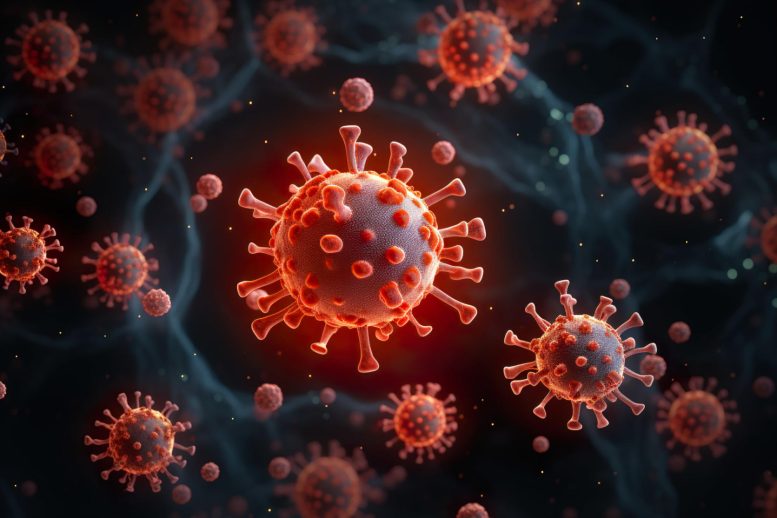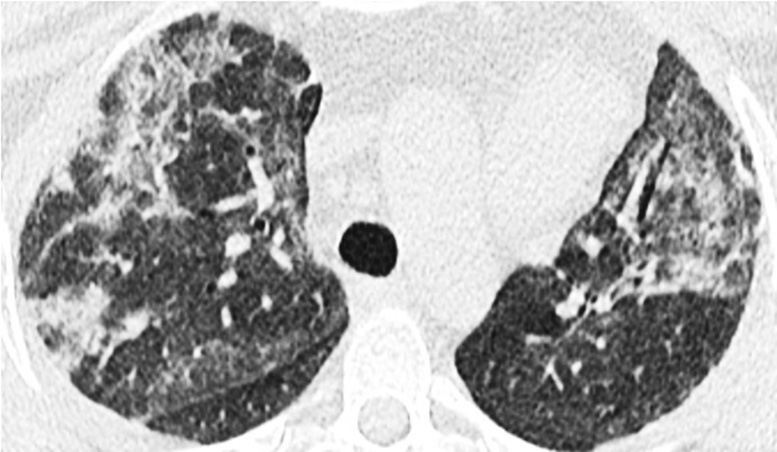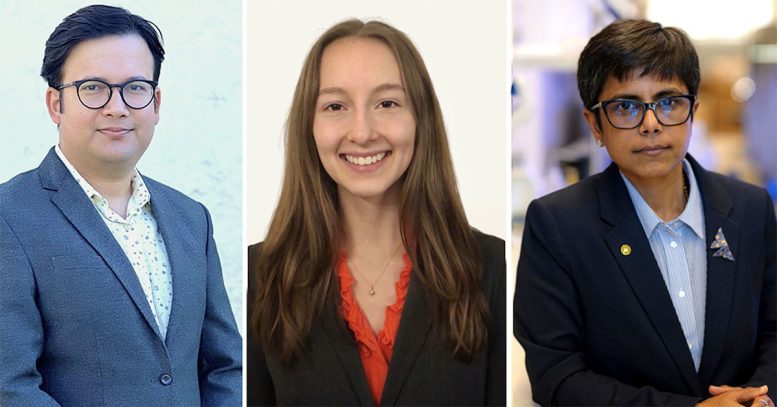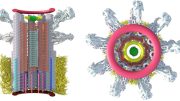
In an international collaboration, scientists have discovered a new COVID-related syndrome, MDA5-autoimmunity and Interstitial Pneumonitis Contemporaneous with COVID-19 (MIP-C). This syndrome, characterized by severe lung scarring and high mortality, was identified using a computational tool, BoNE, which highlighted the role of interleukin-15 in the disease’s progression. The syndrome appears to be a global issue, prompting further research into potential treatments. Credit: SciTechDaily.com
UC San Diego collaborates with UK researchers on a retrospective observational study to unravel a medical mystery.
Pradipta Ghosh, M.D., sat down in her office at the University of California San Diego School of Medicine and considered a request from the other side of the world.
Ghosh, a professor in the Departments of Medicine and Cellular and Molecular Medicine at UC San Diego School of Medicine, received an email from Dennis McGonagle, Ph.D., professor of investigative rheumatology at the University of Leeds in the United Kingdom. It began an international collaboration, one that uncovered a previously overlooked COVID-related syndrome and resulted in a paper in eBioMedicine, a journal published by The Lancet.
McGonagle asked if she was interested in collaborating on a COVID-related mystery. “He told me they were seeing mild COVID cases,” Ghosh said. “They had vaccinated around 90 percent of the Yorkshire population, but now they were seeing this very rare autoimmune disease called MDA5 — autoantibody associated dermatomyositis (DM) in patients who may or may not have contracted COVID, or even remember if they were exposed to it.”

A high-resolution computed tomography of the lungs of a patient with a fatal case of MDA5-autoimmunity and Interstitial Pneumonitis Contemporaneous with the COVID-19 Pandemic (MIP-C). Credit: Image courtesy of Gabriele De Marco, Leeds Biomedical Research Centre, Leeds Teaching Hospitals NHS Trust
McGonagle told of patients with severe lung scarring, some of whom presented rheumatologic symptoms — rashes, arthritis, muscle pain — that often accompany interstitial lung disease. He was curious to know if there was a connection between MDA5-positive dermatomyositis and COVID-19.
“DM is more common in individuals of Asian descent, particularly Japanese and Chinese,” Ghosh said. “However, Dr. McGonagle was noting this explosive trend of cases in Caucasians.”
“But that’s the least of the problem,” Ghosh said. “Because he said, ‘Oh, and by the way, some of these patients are progressing rapidly to death.’”
Leveraging Computational Power in Medical Research
Ghosh is the founding director of the Institute for Network Medicine at UC San Diego School of Medicine, home to the Center for Precision Computational Systems Network (PreCSN — the computational pillar within the Institute for Network Medicine). PreCSN’s signature asset is BoNE — the Boolean Network Explorer, a powerful computational framework for extracting actionable insights from any form of big data.
“BoNE is designed to ignore factors that differentiate patients in a group while selectively identifying what is common (shared) across everybody in the group,” Ghosh explained. Previous applications of BoNE allowed Ghosh and her team to identify other COVID-related lung and heart-afflicting syndromes in adults and children, respectively.
As a rheumatologist, McGonagle specializes in inflammatory and autoimmune conditions. His expertise, combined with the computational power of the Institute for Network Medicine, proved to be an excellent collaboration for probing the post-pandemic upsurge in inflammatory and autoimmune diagnoses. Ghosh said that McGonagle’s roster of patients, all within the U.K.’s National Health System (NHS), helped to facilitate the investigation.

Members of the UC San Diego component of the international team that discovered (and named) MIP-C are (from left) Saptarshi Sinha, Ella McLaren and Pradipta Ghosh. MIP-C is a previously unknown post-COVID syndrome that results in lung scarring, sometimes progressing to death. Credit: UC San Diego Health Sciences
“The NHS has a centralized health care database with comprehensive medical records for a large population, making it easier to access and analyze health data for research purposes,” Ghosh explained.
Ghosh and McGonagle put together a team to probe what they found was indeed an entirely new syndrome. The UC San Diego team included Saptarshi Sinha, Ph.D., interim director of PreCSN, who was a co-first author on the paper, along with Paula David Ramos, M.D., who was conducting research fellowship in experimental rheumatology, at the Leeds Institute of Rheumatic and Musculoskeletal Medicine. The UC San Diego team also included two PreCSN-affiliated students, Ella McLaren, an undergraduate student and aspiring physician-scientist, and Sahar Taheri, a graduate student in the Jacobs School of Engineering Department of Computer Science and Engineering.
The study began with McGonagle lab’s detection of autoantibodies to MDA5 — an RNA-sensing enzyme whose functions include detecting COVID-19 and other RNA viruses. A total of 25 patients from the group of 60 developed lung scarring, also known as interstitial lung disease. Ghosh noted that the lung scarring was bad enough to cause eight people in the group to die due to progressive fibrosis. She said that there are established clinical profiles of MDA5 autoimmune diseases.
“But this was different,” Ghosh said. “It was different in behavior and rate of progression — and in the number of deaths.”
Ghosh and the UC San Diego team explored McGonagle’s data with BoNE. They found that the patients who showed the highest level of MDA5 response also showed high levels of interleukin-15.
“Interleukin-15 is a cytokine that can cause two major immune cell types,” she explained. “These can push cells to the brink of exhaustion and create an immunologic phenotype that is very, very often seen as a hallmark of progressive interstitial lung disease, or fibrosis of the lung.”
BoNE allowed the team to establish the cause of the Yorkshire syndrome — and pinpoint a specific single nucleotide polymorphism that is protective. By right of discovery, the group was able to give the condition a name: MDA5-autoimmunity and Interstitial Pneumonitis Contemporaneous with COVID-19. It’s MIP-C for short, “Pronounced ‘mipsy,’” Ghosh said, adding that the name was coined to make a connection with MIS-C, a separate COVID-related condition of children.
Ghosh said that it’s extremely unlikely that MIP-C is confined to the United Kingdom. Reports of MIP-C symptoms are coming from all over the world. She said she hopes the team’s identification of interleukin-15 as a causative link will jump-start research into treatment.
Reference: “MDA5-autoimmunity and interstitial pneumonitis contemporaneous with the COVID-19 pandemic (MIP-C)” by Paula David, Saptarshi Sinha, Khizer Iqbal, Gabriele De Marco, Sahar Taheri, Ella McLaren, Sheetal Maisuria, Gururaj Arumugakani, Zoe Ash, Catrin Buckley, Lauren Coles, Chamila Hettiarachchi, Emma Payne, Sinisa Savic, Gayle Smithson, Maria Slade, Rahul Shah, Helena Marzo-Ortega, Mansoor Keen, Catherine Lawson, Joanna Mclorinan, Sharmin Nizam, Hanu Reddy, Omer Sharif, Shabina Sultan, Gui Tran, Mark Wood, Samuel Wood, Pradipta Ghosh and Dennis McGonagle, 8 May 2024, eBioMedicine.
DOI: 10.1016/j.ebiom.2024.105136
This work was supported in part by the National Institute for Health Research (NIHR) Leeds Biomedical Research Centre (BRC), and in part by the National Institutes for Health (NIH) grant R01-AI155696 and pilot awards from the University of California Office of the President Research Grants Program Office (R00RG2628, R00RG2642 and R01RG3780) to Pradipta Ghosh. Saptarshi Sinha was supported in part by R01-AI141630 (to Pradipta Ghosh) and in part through funds from the American Association of Immunologists (AAI) Intersect Fellowship Program for Computational Scientists and Immunologists.









As a senior lay American male investigating official US chronic disease and mortality statistics in late 2019 for allergy, FDA approved food poisoning and excessive medical error reasons, I knew early in 2020 that most of the reports of Covid-19 related deaths in the US were greatly exaggerated (e.g., preexisting conditions, comorbidities and innately frail individuals). As to the study cited in the “Re:” lines above, there are at least three fatal flaws in all of “big data.” First, it doesn’t factor-in Dr. Arthur F. Coca’s (by 1935; my) kind of food (minimally) allergy reactions. Second, it doesn’t factor-in officially (FDA in the US approved food poisoning. Third, it doesn’t factor-in excessive related/resultant medical errors. Given the high (e.g., 90) percentage of vaccinated persons in the Yorkshire population, a fourth fatal error could be that the illnesses were caused by the vaccines. Statistically, there never was a Covid-19 pandemic, just a ‘plan-scam-demonic’ of biblical proportions among corporate interests and their pawns and puppets in various national government agencies. Regardless, the first three fatal flaws are sufficient for most serious scientists to completely disregard the results and implications of such a BoNE-head study.
Ever considered validating your claims instead of just making them?
Not my first rodeo, Ho. I started with the US FDA (with replies) in October of 2005 about my early lay findings of connections between allergies, added MSG, chronic disease and obesity (obviously, now, in-vain). Since, I’ve written thousands of professional others including every US attorney’s general and ACLU affiliate in 2006, JACI and The Lancet in 2011 and every US state/territory governor in 2017, updating as possible and occasionally offering to be a 200 pound lab rat. There is something of a ‘class-ceiling’ between college educated professionals relying on so-called “evidence-based” medicine/science and a real life former primarily diagnostic industrial electrician sharing official statistical, professionally published and “experience-based” medicine/science. The tragedy is that once the professionals are trained wrong they are very hard to retrain. Or, maybe it’s the money. As a lone lay victim, investigator, experimenter and discoverer since 1981 I’ve always been mildly ill and never eligible for any of the now $Trillion US that were/are being wasted on drug and genetic research for conditions that are cheaply and easily prevented with diet alone. More on my video channel if you’d like to learn of a few published sources/authors I believe in giving well deserved credit to: https://odysee.com/@charlesgshaver:d?view=about
Good thing this is worldwide and affecting so many all at once, could you imagine how many would ignored & gaslighted by docs as they suffered & died if it weren’t!?
On a different note, it seems like maybe we should classify certain conditions differently.
All too often we say someone has or is experiencing a certain condition, yet the symptoms are numerous full-blown conditions of their own.
Seems we could find a word that allows everyone, even laymen, to understand that the condition being discussed isn’t a single disorder but more akin to a Matryoshka doll.